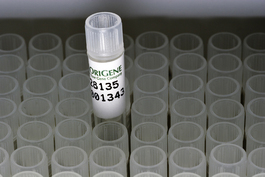Phospholipase C beta 2 (PLCB2) (NM_001284299) Human Untagged Clone
CAT#: SC334408
PLCB2 (untagged) - Human phospholipase C, beta 2 (PLCB2), transcript variant 4
"NM_001284299" in other vectors (1)
Product Images

Specifications
| Product Data | |
| Type | Human Untagged Clone |
| Tag | Tag Free |
| Symbol | PLCB2 |
| Synonyms | PLC-beta-2 |
| Vector | pCMV6-Entry |
| E. coli Selection | Kanamycin (25 ug/mL) |
| Mammalian Cell Selection | Neomycin |
| Sequence Data |
>SC334408 representing NM_001284299.
Blue=Insert sequence Red=Cloning site Green=Tag(s) GCTCGTTTAGTGAACCGTCAGAATTTTGTAATACGACTCACTATAGGGCGGCCGGGAATTCGTCGACTG GATCCGGTACCGAGGAGATCTGCCGCCGCGATCGCC ATGTCTCTGCTCAACCCTGTCCTGCTGCCCCCCAAGGTGAAGGCCTATCTGAGCCAAGGGGAGCGCTTC ATCAAATGGGATGATGAAACTACAGTTGCCTCTCCAGTTATCCTCCGTGTGGATCCTAAGGGCTACTAC TTATACTGGACGTATCAAAGTAAGGAGATGGAGTTTCTGGATATCACCAGCATCCGGGATACTCGCTTT GGGAAGTTTGCCAAGATGCCCAAGAGCCAGAAGCTCCGGGACGTCTTCAACATGGACTTTCCTGATAAC AGTTTCCTGCTGAAGACACTCACGGTGGTGTCCGGCCCGGACATGGTGGACCTCACCTTCCACAACTTC GTCTCCTACAAGGAGAACGTGGGCAAGGCCTGGGCTGAGGACGTACTGGCCCTAGTCAAACATCCGCTG ACGGCCAACGCCTCCCGCAGCACCTTCCTGGACAAGATCCTTGTGAAGCTCAAGATGCAGCTCAACTCT GAAGGGAAGATTCCGGTGAAGAACTTTTTCCAGATGTTTCCTGCTGACCGCAAGCGGGTGGAAGCTGCT CTCAGTGCCTGCCACCTCCCCAAAGGCAAACCTGGAGGAGCGAGATAA ACGCGTACGCGGCCGCTCGAGCAGAAACTCATCTCAGAAGAGGATCTGGCAGCAAATGATATCCTGGAT TACAAGGATGACGACGATAAGGTTTAAACGGCCGGC |
| Restriction Sites |
SgfI-MluI
Plasmid Map

|
| ACCN | NM_001284299 |
| Insert Size | 600 bp |
| OTI Disclaimer | Our molecular clone sequence data has been matched to the reference identifier above as a point of reference. Note that the complete sequence of our molecular clones may differ from the sequence published for this corresponding reference, e.g., by representing an alternative RNA splicing form or single nucleotide polymorphism (SNP). |
| Product Components | The ORF clone is ion-exchange column purified and shipped in a 2D barcoded Matrix tube containing 10ug of transfection-ready, dried plasmid DNA (reconstitute with 100 ul of water). |
| Reconstitution | 1. Centrifuge at 5,000xg for 5min. 2. Carefully open the tube and add 100ul of sterile water to dissolve the DNA. 3. Close the tube and incubate for 10 minutes at room temperature. 4. Briefly vortex the tube and then do a quick spin (less than 5000xg) to concentrate the liquid at the bottom. 5. Store the suspended plasmid at -20°C. The DNA is stable for at least one year from date of shipping when stored at -20°C. |
| Reference Data | |
| RefSeq | NM_001284299.1 |
| RefSeq Size | 1840 bp |
| RefSeq ORF | 600 bp |
| Locus ID | 5330 |
| Cytogenetics | 15q15.1 |
| Protein Families | Druggable Genome |
| Protein Pathways | Alzheimer's disease, Calcium signaling pathway, Chemokine signaling pathway, Gap junction, GnRH signaling pathway, Huntington's disease, Inositol phosphate metabolism, Long-term depression, Long-term potentiation, Melanogenesis, Metabolic pathways, Phosphatidylinositol signaling system, Taste transduction, Vascular smooth muscle contraction, Wnt signaling pathway |
| MW | 22.7 kDa |
| Gene Summary | The protein encoded by this gene is a phosphodiesterase that catalyzes the hydrolysis of phosphatidylinositol 4,5-bisphosphate to the second messengers inositol 1,4,5-trisphosphate (IP3) and diacylglycerol. The encoded protein is activated by G proteins and has been shown to be involved in the type 2 taste receptor signal transduction pathway. In addition, nuclear factor kappa B can regulate the transcription of this gene, whose protein product is also an important regulator of platelet responses. [provided by RefSeq, Jan 2017] Transcript Variant: This variant (4) lacks multiple 3' coding exons and contains an alternate 3' terminal exon, resulting in a distinct 3' coding region and 3' UTR, compared to variant 1. The encoded isoform (4) is shorter and has a distinct C-terminus, compared to isoform 1. |
Documents
| Product Manuals |
| FAQs |
| SDS |
Resources
Other Versions
| SKU | Description | Size | Price |
|---|---|---|---|
| RC236514 | PLCB2 (myc-DDK-tagged) - Human phospholipase C, beta 2 (PLCB2), transcript variant 4 |
USD 420.00 |
{0} Product Review(s)
Be the first one to submit a review






























































































































































































































































 Germany
Germany
 Japan
Japan
 United Kingdom
United Kingdom
 China
China
